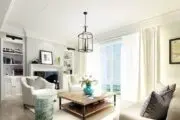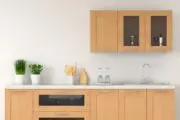While there is no underestimating the value of good advice from a trained design professional when designing and decorating your home, sometimes that isn’t in the budget. Or, perhaps you are a motivated and inspired homeowner, keen to DIY. Whatever the motivation, here are some DIY interior design hacks to guide your process.
Planning and budget
A designer will create a plan around your budget and guide you toward appropriate choices. As a first step in your DIY interior design, set your budget.
Decide what you can afford, and then plan from there, not the other way around. When setting a budget, remember to plan for contingencies.
Make a smart wish list
While a wish list is meant to be aspirational, to think like a designer, you need to have a more pragmatic approach. Each design decision intersects with, or layers on another, so be conscious of how your choices will affect everyday living, as well as the aesthetic tone.
This means adopting a function-first attitude. Rather than listing your preferred features and finishes from your Pinterest board, the wish list needs to start with a series of questions:
- What is your lifestyle, and how do you want to live in the space(s) in question?
- What works in your current home, and what doesn’t?
- How many members are in the household?
- Does anyone have any special needs (i.e., children or seniors)?
- Do you need space for hobbies or for working from home?
- What do you need in your kitchen? Do you cook often or order out? Do you entertain?
- What is your aesthetic or preferred style?
- What is your favorite travel destination, hotel, restaurant, or fashion style? (your home aesthetic often draws inspiration from these places)
- Do you have anything that you currently own that you must incorporate in the new build or home renovation? Often homeowners have vintage pieces or pieces with sentimental value, such as furniture or artwork that can blend in strategically.
Answering questions such as these will help you to determine your floor plan and how you might design and decorate your home.
Use apps, AI, and AR to stoke inspiration
With new apps and emerging tech, it’s easy for homeowners to experiment with desired aesthetics for inspiration, and to have a more comprehensive understanding of what design and decor choices might look like.
Dabble with generative AI Midjourney. Using text-to-image prompts, you can see your design ideas literally come to life before your eyes in under a minute. Experimenting with Midjourney is a great way to try out different looks, finishes and space arrangements.
It’s an effective way to assemble a mood board (which is a must-have at the beginning of an interior design project) and it is also helpful in articulating design concepts effectively to others.
Many retailers in housing goods, home improvement, housing supplies, and décor offer AR technology.
Using a smart phone to capture a space, a photo, or a pre-selected room design, it’s easy to visualize how a piece of furniture, paint color or cabinet selections might look.
There are tons of apps and visualizers out there from small and large companies alike, but some of the notables include IKEA, Cambria, and Benjamin Moore.
Apps that can measure your space are particularly good, as they can help with proportions and scale.
Space planning and furniture placement
Consider a room’s purpose, and what the focal point should be, and arrange furniture around that focal point.
Right-sized furniture matters in the overall impression of a room and will either hinder or help functionality.
A small room doesn’t necessarily mean small furniture and vice versa. It’s about achieving balance and scale to the proportion of the room. Measure the furniture and remember to include bases. Ensure that there is adequate clearance to comfortably move around furniture (usually a couple of feet).
Layer your lighting
There is an art to lighting, and when it is done correctly it enhances the functionality and aesthetics of a space. The key is to use layers.
To layer lighting, incorporate ambient, task and decorative lighting. Ambient lighting could be from natural light, or additional lighting that provides general illumination. Task lighting is more directed and task-specific, such as a desk lamp, while accent lighting adds decorative flair.
Create zones
Especially important in an open-concept floor plan, or in homes with multi-purpose spaces, defining zones dedicated to purpose will enhance functionality.
You can delineate space without disrupting sightlines by using area rugs and arranging furniture in conversation clusters, for example in an open-concept main floor. Or, you can position a sofa to create a room within a room.
Use subtle transitions in color or different types of flooring to signal different “rooms”.
Add half-walls or high archways to signal a split in spaces, for example between a kitchen and dining area.
Don’t underestimate the need for storage
One of the ways to make your home more functional is to ensure there is adequate storage. This is especially important in smaller homes, or in homes that feature open-concept floor plans, that benefit from wide sightlines, but also don’t allow for clutter.
Look for ways to include storage in furniture, such as lift-up ottomans and sofas. Get more functionality out of cabinetry with pull-outs and drawer dividers. Use closet systems to maximize usable space.
Just one DIY project? Think ahead
Even if you are tackling a single room or project, look at your choices in the context of your overall aesthetic in terms of style, finishes and features.
One thing that designers do very well is to look at homes holistically, to ensure that rooms and spaces flow and are cohesive. Consider how choices today will blend in with work you’ve already done, and with your future wish list.
Additional DIY interior design hacks
- Measure everything. And measure again.
- Get physical samples of everything that you can, in as large a format as you can, so that you can feel items, as well as see how different finishes, colors and fabrics react to different lighting.
- Consider durability and practicality of colors and finishes in context of your lifestyle to guide choices.
- Look for in-store consultants, who can help narrow down selections, and may have hands-on knowledge about products and materials.
- If you are a new build homeowner, ask your builder’s design center consultant for advice at the design studio.








